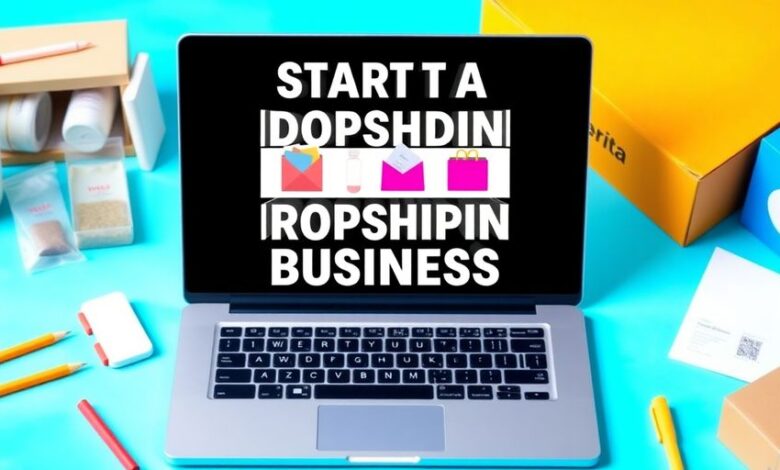
Thinking about starting a dropshipping business in 2025? You’re in the right place! This guide breaks down everything you need to know, from picking a niche to marketing your store. Dropshipping can be a smart way to dive into e-commerce without the hassle of managing inventory. Let’s get started on your journey to becoming a successful dropshipper!
Key Takeaways
- Dropshipping lets you sell products without holding inventory, making it a low-risk business model.
- Choosing the right niche and products is crucial for success; not all items will sell well.
- Building a strong online store is essential; focus on user experience and essential features.
- Finding reliable suppliers can make or break your business; do your research and build good relationships.
- Effective marketing strategies, including social media and SEO, are key to attracting customers.
Understanding Dropshipping and Its Benefits
What Is Dropshipping?
Okay, so what is dropshipping? Basically, it’s a way to run an online store without actually having to deal with any inventory. You don’t buy or store any products yourself. Instead, when a customer buys something from your store, you simply forward the order to a third-party supplier. They then ship the product directly to the customer. Think of it as being the middleman, but without all the usual hassle. It’s a popular business model because the startup costs are low. You can start their own businesses with minimal investment.
Here’s a simple breakdown:
- Customer places an order on your website.
- You forward the order to your supplier.
- The supplier ships the product directly to the customer.
Advantages of Dropshipping
Dropshipping has some pretty cool advantages, especially if you’re just starting out. For one, you don’t need a ton of money to get started. Since you’re not buying inventory upfront, your initial investment is super low. Plus, it’s easy to get going. You don’t need a warehouse, or a team to pack and ship orders. Suppliers handle all that. You can offer a wide selection of products without worrying about storage space. And, you can run your business from anywhere with an internet connection. It offers the ability to scale quickly and work from anywhere, giving you the freedom to grow your business at your own pace. Here’s a quick look at some of the main perks:
- Low startup costs
- No need to manage inventory
- Wide product selection
- Flexibility to work from anywhere
Dropshipping can be a great way to test out new product ideas without risking a lot of money. It allows you to quickly adapt to market trends and customer demands.
Common Misconceptions About Dropshipping
There are some misconceptions about dropshipping. Some people think it’s a get-rich-quick scheme, but it’s not. It takes work to find good suppliers, market your store, and provide good customer service. Also, some people think that because you don’t handle inventory, it’s completely hands-off. But you still need to manage your website, handle customer inquiries, and track orders. It’s also not always super profitable right away. You might have lower profit margins compared to traditional retail, especially when you’re competing on price. You may need to subscribe to a supplier service to access catalogs and see more products. Also, consider investing in advertising. Dropshipping expenses are highly individual and can vary significantly depending on the platforms you use to source and sell products.
Choosing Your Niche and Products
This is where the rubber meets the road! You can’t just sell anything and expect to succeed. Picking the right niche and products is super important for your dropshipping venture. It’s about finding that sweet spot where demand meets profitability.
Identifying Profitable Niches
Finding a profitable niche is like finding gold. It’s all about balancing market size with competition. You want a niche that’s not too broad (think “clothing”) because you’ll be fighting with everyone. But you also don’t want it so narrow that nobody’s interested (like “left-handed banjo accessories”).
Here’s a simple approach:
- Start with your passions: What are you genuinely interested in? Your knowledge will be a huge asset.
- Look at trends: What’s hot right now? Google Trends can be your best friend.
- Assess the competition: Are there already a million dropshippers in that niche? Maybe rethink it.
A good niche is specific enough to target a dedicated customer base, but broad enough to offer a variety of products and growth potential. Think about underserved markets or unique product combinations.
Researching Market Trends
Market research isn’t just for big corporations. It’s essential for dropshippers too! You need to know what’s selling, what’s fading, and what’s about to blow up. There are some great tools to help you with this. Using keyword research can show you what people are searching for online.
Here are some ways to stay on top of trends:
- Google Trends: This is a free tool that shows you the popularity of search terms over time.
- Social Media: See what’s trending on platforms like TikTok, Instagram, and Pinterest.
- Competitor Analysis: What are your competitors selling? What are their bestsellers?
Selecting the Right Products
Okay, you’ve got your niche. Now it’s time to pick the actual products you’ll be selling. This isn’t just about choosing what you like; it’s about choosing what your customers will love. You want high-quality products people enjoy. You can find dropshipping niches to get inspiration and find profitable product ideas.
Consider these factors when selecting products:
- Profit Margin: Can you make a decent profit after all expenses?
- Shipping Costs: Are the shipping costs reasonable? Heavy or bulky items can kill your margins.
- Product Quality: Order samples to check the quality yourself. You don’t want to sell junk.
| Factor | Description
Setting Up Your Online Store
Alright, so you’ve got your niche picked out and some killer products lined up. Now it’s time to build your online store. This is where things get real – your store is your digital storefront, and it needs to look good and function even better. Let’s break down how to make it happen.
Choosing an E-commerce Platform
Selecting the right e-commerce platform is a critical decision. You’ve got a bunch of options, each with its own pros and cons. Think of platforms like Shopify, WooCommerce (for WordPress), or BigCommerce. Shopify is super popular because it’s user-friendly and has tons of apps to add extra features. WooCommerce gives you more control since it’s open-source, but it can be a bit more technical. BigCommerce is great for larger businesses with more complex needs. Consider what features are most important to you – payment gateways, marketing tools, analytics – and pick a platform that checks those boxes. Don’t forget to check out Shopify’s store builder to see if it fits your needs.
Designing Your Storefront
Your storefront is like the face of your business, so make it look good! Here’s the deal: your design needs to be clean, easy to navigate, and reflect your brand. Use high-quality images of your products – no blurry pics allowed! Write clear and detailed product descriptions. Make sure your site is mobile-friendly because a ton of people shop on their phones. Think about your target audience and design a site that appeals to them. A well-designed storefront builds trust and encourages people to buy.
Essential Features for Your Store
Okay, so you’ve got the basics down. Now, let’s talk about the must-have features for your dropshipping store:
- About Us, Contact Us, and FAQ pages: These build trust and show customers you’re legit.
- Store policies: Delivery, returns, exchanges, and privacy – cover all your bases.
- Secure payment gateway: Make sure customers feel safe entering their payment info.
- Mobile-friendly design: Most people shop on their phones, so your site needs to look good on any device.
- Product reviews: Let customers share their experiences and build social proof.
Don’t forget about SEO! Optimize your product pages and descriptions with relevant keywords to help people find your store on search engines. This is a long-term strategy, but it’s worth the effort.
Setting up your online store might seem daunting, but it’s a crucial step in starting your dropshipping business. Take your time, do your research, and create a store that you’re proud of. With the right platform, design, and features, you’ll be well on your way to success.
Finding Reliable Suppliers

Finding the right suppliers is super important for your dropshipping business. They’re basically your partners in this, and their reliability can make or break your store. You need suppliers who can consistently deliver quality products on time. It’s not just about finding someone who has what you want; it’s about finding someone you can trust.
How to Source Suppliers
Okay, so where do you even find these suppliers? There are a few main routes you can take. First, online marketplaces like AliExpress are a good starting point. They have tons of products and suppliers, but you need to be careful about vetting them. Wholesale directories, such as SaleHoo, are another option. These directories usually verify their suppliers, which can save you some headaches. Finally, there are dropshipping platforms that connect you with suppliers, often with a focus on specific regions or product types.
Here’s a quick rundown:
- Online Marketplaces: Huge selection, but requires careful vetting.
- Wholesale Directories: Verified suppliers, more reliable.
- Dropshipping Platforms: Curated suppliers, often with specific focuses.
Evaluating Supplier Reliability
So, you’ve found a few potential suppliers. Now what? You need to evaluate how reliable they actually are. Don’t just take their word for it! Order samples to check the product quality and shipping times. Read reviews and look for any red flags. Check their customer service – are they responsive and helpful? Also, make sure they have a clear return policy.
It’s better to spend a little extra time upfront to find a reliable supplier than to deal with constant headaches and unhappy customers down the road.
Here are some key things to look for:
- Product Quality: Are the products well-made and as described?
- Shipping Times: Are they consistent and reasonable?
- Customer Service: Are they responsive and helpful?
- Return Policy: Is it clear and fair?
Building Relationships with Suppliers
Once you’ve found a reliable supplier, don’t just treat them like a faceless entity. Building a good relationship can pay off big time. Communicate clearly, pay on time, and be respectful. If you treat them well, they’re more likely to go the extra mile for you. This could mean better pricing, faster shipping, or even early access to new products. Think of it as a partnership, not just a transaction.
Here’s how to build those relationships:
- Communicate clearly and promptly.
- Pay invoices on time.
- Be respectful and professional.
- Provide constructive feedback.
Building strong relationships with your suppliers is key to long-term success in dropshipping.
Registering Your Business Legally
It’s easy to overlook the legal stuff when you’re eager to launch your dropshipping store, but trust me, it’s super important. Getting this right from the start can save you a ton of headaches (and money!) down the road. We’re talking about protecting your personal assets and making sure you’re not breaking any laws. Let’s break down the key steps.
Choosing a Business Structure
Okay, first things first: you need to decide what kind of business you’re running. This choice has big implications for taxes and liability. The most common options are:
- Sole Proprietorship: This is the simplest. It’s basically you operating under your own name. Easy to set up, but you’re personally liable for all business debts. If someone sues your business, they’re suing you.
- Limited Liability Company (LLC): This separates your personal assets from your business debts. It’s a bit more complicated to set up than a sole proprietorship, but the liability protection is worth it. Many small dropshippers choose this. An LLC offers flexible tax benefits compared to a sole proprietorship.
- C Corporation: This is a more complex structure, usually for larger businesses. It offers the most protection but comes with more paperwork and potential for double taxation. Probably overkill for most dropshipping startups.
Choosing the right structure depends on your risk tolerance and long-term goals. It’s always a good idea to chat with a legal or financial advisor to figure out what’s best for your specific situation.
Registering Your Business Name
Once you’ve picked a structure, you’ll likely need to register your business name. This might involve checking if the name is available and filing some paperwork with your state or local government. If you’re operating as a sole proprietor under a name different from your own, you’ll probably need to file a “Doing Business As” (DBA) name. This ensures that the public knows who’s behind the business. Make sure your dropshipping website is verified by a trusted third party.
Understanding Tax Obligations
Taxes. Everyone’s favorite topic, right? As a business owner, you’re responsible for collecting and paying sales tax, as well as income tax on your profits. The specifics vary depending on your location and business structure, so do your homework. You’ll likely need an Employer Identification Number (EIN) from the IRS, which is like a Social Security number for your business. You can apply for a free EIN online through the IRS. Keeping your business and personal finances separate will give you full visibility into what you’re spending on your business. Ignoring tax obligations can lead to serious penalties, so don’t skimp on this step!
Marketing Your Dropshipping Business

Okay, so you’ve got your store set up, products ready to go, and the legal stuff sorted. Now comes the fun part (and arguably the most important): getting people to actually buy your stuff. You could have the best products in the world, but if nobody knows about them, you’re not going to make any sales. Marketing is how you bridge that gap.
Creating a Marketing Strategy
First things first, you need a plan. Don’t just randomly throw money at ads and hope for the best. Think about who your ideal customer is, where they spend their time online, and what kind of messaging will resonate with them. A well-defined marketing strategy is the backbone of your dropshipping success. Consider these points when crafting your strategy:
- Target Audience: Who are you trying to reach? Age, interests, income level?
- Marketing Channels: Where will you focus your efforts? Social media, search engines, email?
- Budget Allocation: How much can you afford to spend on marketing each month?
- Key Performance Indicators (KPIs): How will you measure success? Website traffic, conversion rates, sales?
It’s easy to get overwhelmed by all the marketing options out there. Start small, test different approaches, and see what works best for your specific niche and target audience. Don’t be afraid to adjust your strategy as you learn more.
Utilizing Social Media
Social media is a powerful tool for dropshipping businesses. It allows you to connect with potential customers, build brand awareness, and drive traffic to your store. But it’s not enough to just create a Facebook page and start posting random stuff. You need to be strategic about your social media presence.
- Choose the Right Platforms: Focus on the platforms where your target audience spends their time. If you’re selling products to teenagers, TikTok and Instagram might be good choices. If you’re selling products to professionals, LinkedIn might be a better fit.
- Create Engaging Content: Post high-quality images and videos that showcase your products. Run contests and giveaways to generate excitement. Share customer testimonials and reviews to build trust.
- Run Targeted Ads: Use social media advertising to reach specific demographics and interests. This can be a cost-effective way to drive traffic to your store.
Implementing SEO Techniques
Search Engine Optimization (SEO) is the process of optimizing your website and content to rank higher in search engine results pages (SERPs). This is important because the higher you rank, the more organic traffic you’ll get to your store. And organic traffic is free!
- Keyword Research: Identify the keywords that your target audience is using to search for products like yours. Use these keywords throughout your website content, product descriptions, and blog posts.
- On-Page Optimization: Optimize your website’s title tags, meta descriptions, and header tags. Make sure your website is mobile-friendly and loads quickly.
- Link Building: Get other websites to link to your website. This will help improve your website’s authority and ranking in search results.
| SEO Tactic | Description
Managing Finances and Operations
Okay, so you’ve got your store set up, products chosen, and suppliers lined up. Now comes the part where you actually run the business. This means dealing with the money and making sure everything runs smoothly. It might not be the most exciting part, but it’s super important to get right.
Setting Up Payment Processing
First things first, you need to get paid! Setting up payment processing is how you’ll receive money from your customers. There are a bunch of options out there, like PayPal, Stripe, and even some that integrate directly with your e-commerce platform. Consider the fees associated with each, as they can eat into your profits. Make sure the payment gateway is secure and reliable. Nobody wants their credit card info stolen.
Tracking Expenses and Revenue
This is where things can get a little tedious, but trust me, it’s worth it. You need to keep a close eye on where your money is going and where it’s coming from. Use accounting software or even a simple spreadsheet to track every expense and every sale. This will help you see if you’re actually making money and where you can cut costs.
Here’s a simple table to illustrate:
| Category | January | February | March |
|---|---|---|---|
| Revenue | $2000 | $2500 | $3000 |
| Advertising | $500 | $600 | $700 |
| Supplier Costs | $800 | $1000 | $1200 |
| Platform Fees | $50 | $50 | $50 |
| Net Profit | $650 | $850 | $1050 |
Understanding Shipping and Fulfillment
Even though you’re dropshipping, you still need to understand how shipping works. Your supplier handles the actual shipping, but you’re responsible for setting customer expectations.
Here are some things to keep in mind:
- Shipping Times: Be upfront about how long it will take for orders to arrive. Overpromise, and you’ll have unhappy customers.
- Shipping Costs: Decide how you’ll handle shipping costs. Will you offer free shipping, charge a flat rate, or calculate it based on weight and destination?
- Tracking Information: Make sure your supplier provides tracking information so customers can see where their orders are. This reduces anxiety and improves customer satisfaction.
It’s a good idea to have a separate bank account and credit card just for your business. This makes it way easier to track your finances and keeps things organized. Plus, it can help you build business credit, which can be useful down the road.
Analyzing and Optimizing Your Business
Alright, you’ve got your dropshipping store up and running. But don’t think you can just sit back and watch the money roll in. The real work starts now. You need to constantly analyze what’s happening and tweak things to improve. Think of it like tending a garden – you can’t just plant seeds and walk away. You’ve got to weed, water, and adjust as needed.
Using Analytics Tools
Analytics are your best friend. Seriously. You need to know where your traffic is coming from, what products are selling, and where people are dropping off during the checkout process. Google Analytics is a must-have, and most e-commerce platforms have their own built-in analytics dashboards. Pay attention to metrics like bounce rate, conversion rate, and average order value. These numbers tell a story, and it’s your job to figure out what that story is. For example, use Google Search Console to see how your website performs in search results and where to find areas for improvement.
Gathering Customer Feedback
Don’t just rely on numbers. Talk to your customers! Send out surveys, read reviews, and respond to comments on social media. Find out what they like, what they don’t like, and what they wish you offered. Customer feedback is invaluable for improving your products, your website, and your overall customer experience.
Here are a few ways to gather feedback:
- Send out post-purchase surveys via email.
- Actively monitor social media for mentions of your brand.
- Encourage customers to leave reviews on your product pages.
Making Data-Driven Decisions
All this data and feedback is useless if you don’t actually do anything with it. Use what you learn to make informed decisions about your business. Are certain marketing channels not performing well? Cut them. Are customers complaining about shipping times? Find a faster supplier. Are some products consistently out of stock? Always look for alternatives to mitigate risks and keep products in stock. Don’t be afraid to experiment and try new things, but always base your decisions on data, not gut feeling.
It’s easy to get caught up in the day-to-day tasks of running a business, but it’s important to take a step back and look at the big picture. Regularly analyzing your business and making data-driven decisions is the key to long-term success in the dropshipping world.
Wrapping It Up
Starting a dropshipping business in 2025 can be a great way to dive into the world of e-commerce without the heavy costs of inventory. Remember, it’s all about picking the right niche, finding trustworthy suppliers, and marketing your store effectively. Don’t forget to keep an eye on your competitors and adapt as needed. It might take some time and effort, but with persistence, you can build a successful dropshipping venture. So, take that first step, stay focused, and watch your business grow!
Frequently Asked Questions
What is dropshipping?
Dropshipping is a way to sell products online without keeping any stock. When someone buys from your store, you order the item from a supplier who ships it directly to the customer.
What are the benefits of dropshipping?
Dropshipping has many benefits, like low startup costs, no need to manage inventory, and the ability to work from anywhere.
How do I pick a good niche?
To choose a niche, think about what interests you and research what products are popular and in demand. Avoid very broad niches to stand out.
How do I find reliable suppliers?
You can find suppliers by using platforms like AliExpress or SaleHoo. Always check reviews and communicate with them to ensure they are trustworthy.
Do I need to register my dropshipping business?
Yes, it’s important to register your business to make it legal. This usually involves choosing a business name and structure, and understanding any tax responsibilities.
How can I market my dropshipping store?
You can market your store through social media, email marketing, and search engine optimization (SEO) to attract customers and increase sales.



